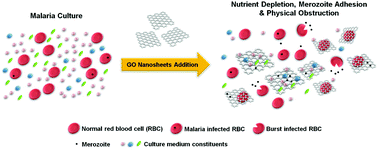Graphene oxide inhibits malaria parasite invasion and delays parasitic growth in vitro†
Abstract
The interactions between graphene oxide (GO) and various biological entities have been actively investigated in recent years, resulting in numerous potential bioapplications of these nanomaterials. Despite this, the biological interactions between GO and disease-causing protozoan parasites have not been well elucidated and remain relatively unexplored. Here, we investigate the in vitro interactions between GO nanosheets and a particular species of malaria parasites, Plasmodium falciparum (P. falciparum). We hypothesize that GO nanosheets may exhibit antimalarial characteristic via action mechanisms of physical obstruction of P. falciparum parasites as well as nutrient depletion. To ascertain this, we characterize the physical interactions between GO nanosheets, red blood cells (RBCs), and malarial parasites as well as the adsorption of several biomolecules necessary for parasitic survival and growth on GO nanosheets. Subsequent to establishing the origin of this antimalarial behavior of GO nanosheets, their efficiency in inhibiting parasite invasion is evaluated. We observe that GO nanosheets at various tested concentrations significantly inhibit the invasion of malaria parasites into RBCs. Furthermore, GO nanosheets delay parasite progression from the ring to the trophozoite stage. Overall, this study may further shed light on the graphene-parasite interactions and potentially facilitate the development of nanomaterial-based strategies for combating malaria.



 Please wait while we load your content...
Please wait while we load your content...